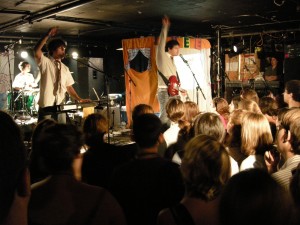Long time, no blog – it’s been a frenetic semester, though my classes at Boston College were exceptionally rewarding – I had two super-talented sets of students. So super-talented, in fact, that I went and got an anthology of their work published through the Espresso Book Machine in the Harvard Bookstore. I asked each student to select 5 pages of their best work from the semester and compiled each class’ work into a PDF file, which I emailed to the Harvard Book Store. Poof! Like magic, the following day I picked up 15 copies of each file, hot off the press and looking like real paperback books. The vibrant covers were each designed by a student also.
Aside from teaching, I’ve been doing a few readings - at the terrific “Art to Art” monthly series at The Piano Factory in the South End, and at a “Fantastical Literary Salon” with the literary luminaries Ethan Gilsdorf, Chip Cheek, KL Pereira, Cam Terwilliger and Sue Williams. Last weekend I also moderated a panel at the Muse and the Marketplace Panel in the Park Plaza Hotel:
“Agents on the Hot Seat – Fiction Focus with Lisa Grubka, PJMark, Denise Shannon and Rachel Sussman.” Despite being hot shot New York agents, they were each incredibly warm and down to earth and the panel was a delight to chair. The weekend was a wonderful, inspirational whirlwind and my friend Gail Waldstein was also in town from Denver, and gave me a copy of her exquisite, brave gem of a memoir: “To Quit This Calling: Firsthand Tales of a Pediatric Pathologist”.
On a separate note, I’m seriously thinking of getting my yoga license, to teach in prisons. I’ve been taking yoga classes at Exhale Spa every day (my favorite teachers being Amy Leydon and David Magone) and I’ve been learning mindful meditation with Jennifer Wade. Both yoga and meditation are profoundly changing my life. Aside from making my healthier, they are giving me tools for controlling and changing unhelpful mind and behavioral patterns that have been hindering me my entire life. They are both so self-empowering and freeing and a wonderful compliment to writing which is empowering in its own way, but also very sedentary and ungrounding at times (especially if you focus on fantastical fiction, like I often do). I’ll be teaching a creative writing workshop at a correction center in the fall and I’d love to teach a yoga/meditation course to prisoners next year – Downward Facing Dog hits the spot even better than a double vodka.
p.s. Two fresh/funny articles on the writing life, if you haven't already read them: 1) http://www.guardian.co.uk/books/2010/feb/20/ten-rules-for-writing-fiction-part-one (from the series http://www.guardian.co.uk/books/series/rules-for-writers) 2) http://www.salon.com/books/laura_miller/2010/02/23/readers_advice_to_writers




